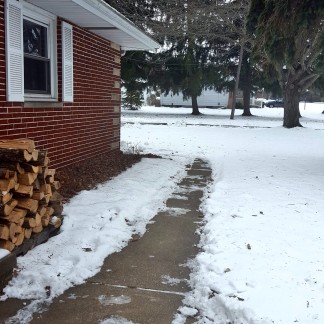 Winter doesn’t officially arrive for another 5 days, but here, in Northeast Ohio, winter doesn’t wait for a day on the calendar. This week we’ve seen significant snow, lows tickling zero, and highs a far reach from the freezing point. This winter weather has brought a new question to my edible landscaping ideas. How do I safely keep ice off the sidewalks?
Winter doesn’t officially arrive for another 5 days, but here, in Northeast Ohio, winter doesn’t wait for a day on the calendar. This week we’ve seen significant snow, lows tickling zero, and highs a far reach from the freezing point. This winter weather has brought a new question to my edible landscaping ideas. How do I safely keep ice off the sidewalks?
We shoveled the sidewalks, but there is still a good bit of ice there. We don’t use this sidewalk a lot, but it leads to the main door our guests use. Of course the go to for clearing ice is salt, but is that safe for my blueberries, cranberries, and other edibles in that bed?
My instinct is no, especially when I remember the homemade weed spray I made a few years ago. One of the ingredients was salt. Time to do a little research. I found quite a bit of information, but most of it was talking about road salt and the damage it causes to plants. From the articles I read, the most damage is caused by the salt water spray, like the weed spray I made, like the spray from the roads. Salt water spray wouldn’t be a concern from my sidewalk.
There can also be damage from salt in the soil. The sodium and chloride in salt interferes with the plants’ intake of other nutrients. It can also affect the amount of water available to the plant, and the overall soil quality.
There are things that can be done to reduce the damage to your plants. You can use a different deicer. Rock salt (sodium chloride) is what most commonly used because it is cheap. Other salts, like calcium chloride, cause less damage. Sand or cinders can also be used. Barriers can be used to protect from salt spray, and soil can be heavily watered in better weather to wash out some of the salts.
So about my beds next to the sidewalk. . .I can limit the amount of deicing agent I use. Sand or cinders aren’t really practical here because of the mess. Since I will likely use a small amount of salt, I probably would be ok with sodium chloride. The flip side of that is because I’ll use a small amount, a more expensive (safer for plants) option would not be that much of an extra expense, and that is the choice I am making.
If you’d like to do some reading for yourself, the most helpful articles I found were from Purdue Extension and the University of Massachusetts. The Purdue article contains a nice chart comparing different de-icing agents, and both contain lists of salt tolerant plant (mostly trees) that would be helpful if you want to plant where you can’t control the salt application or spray.